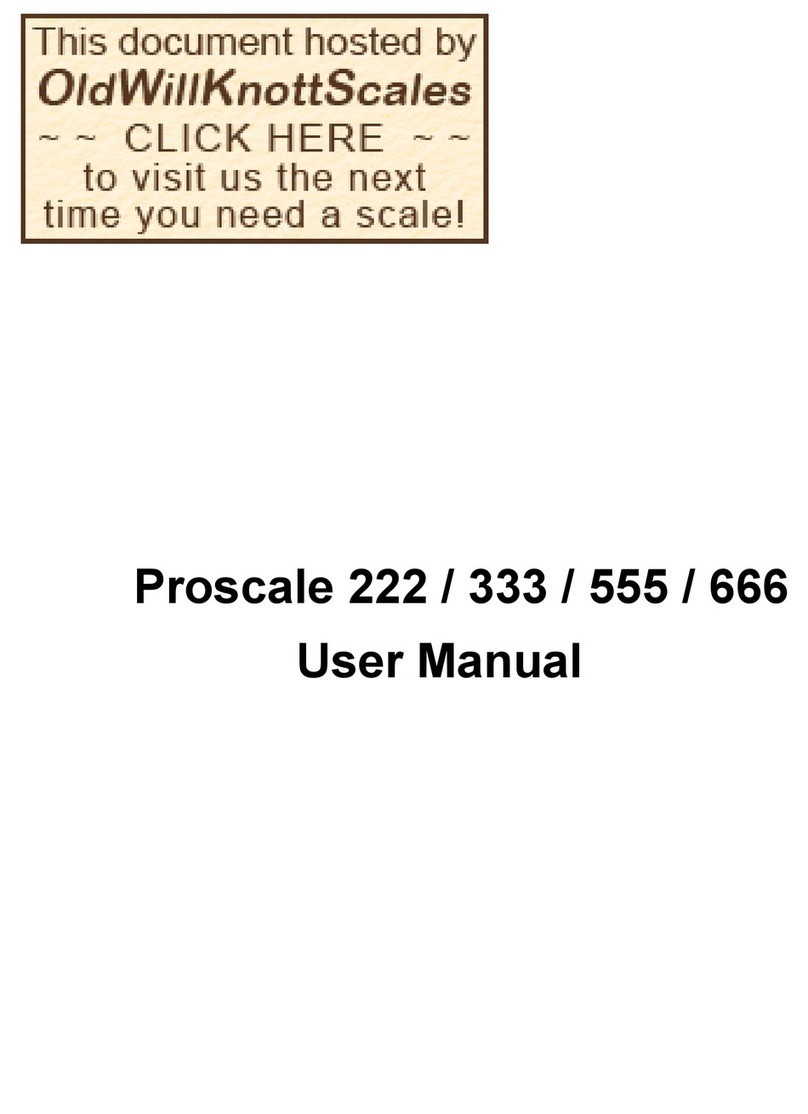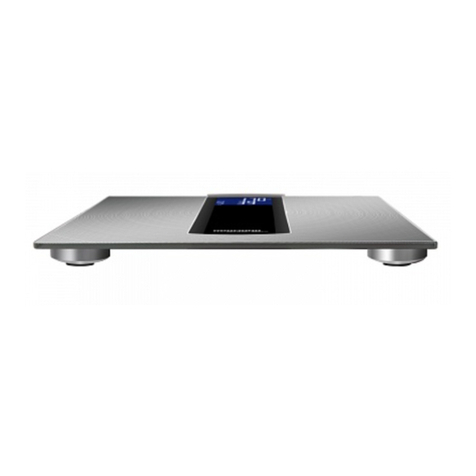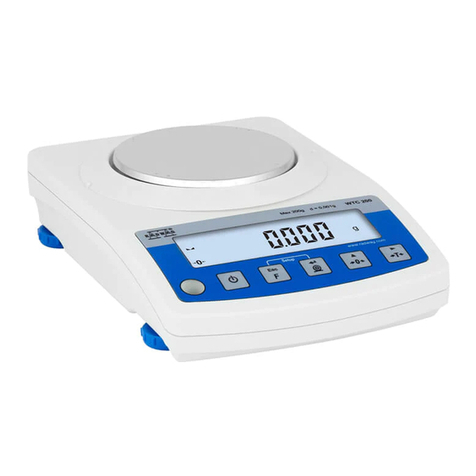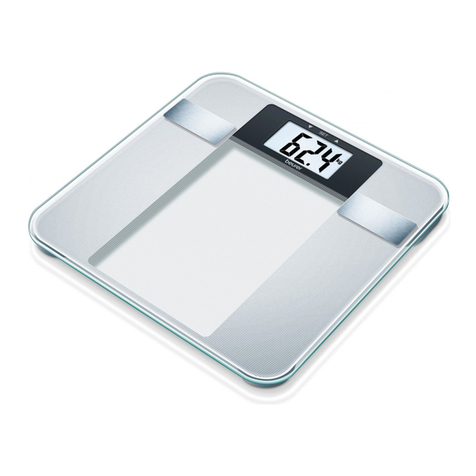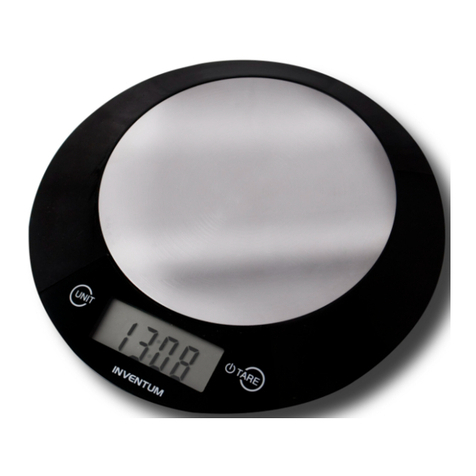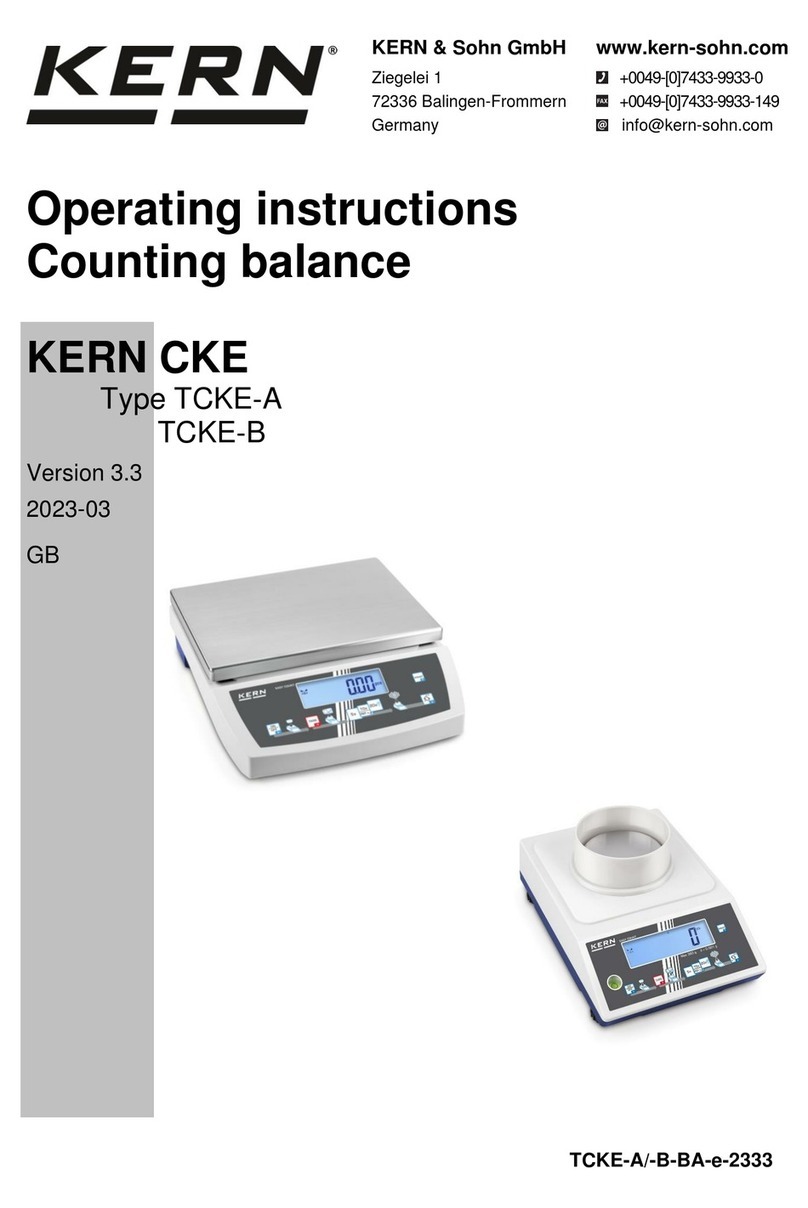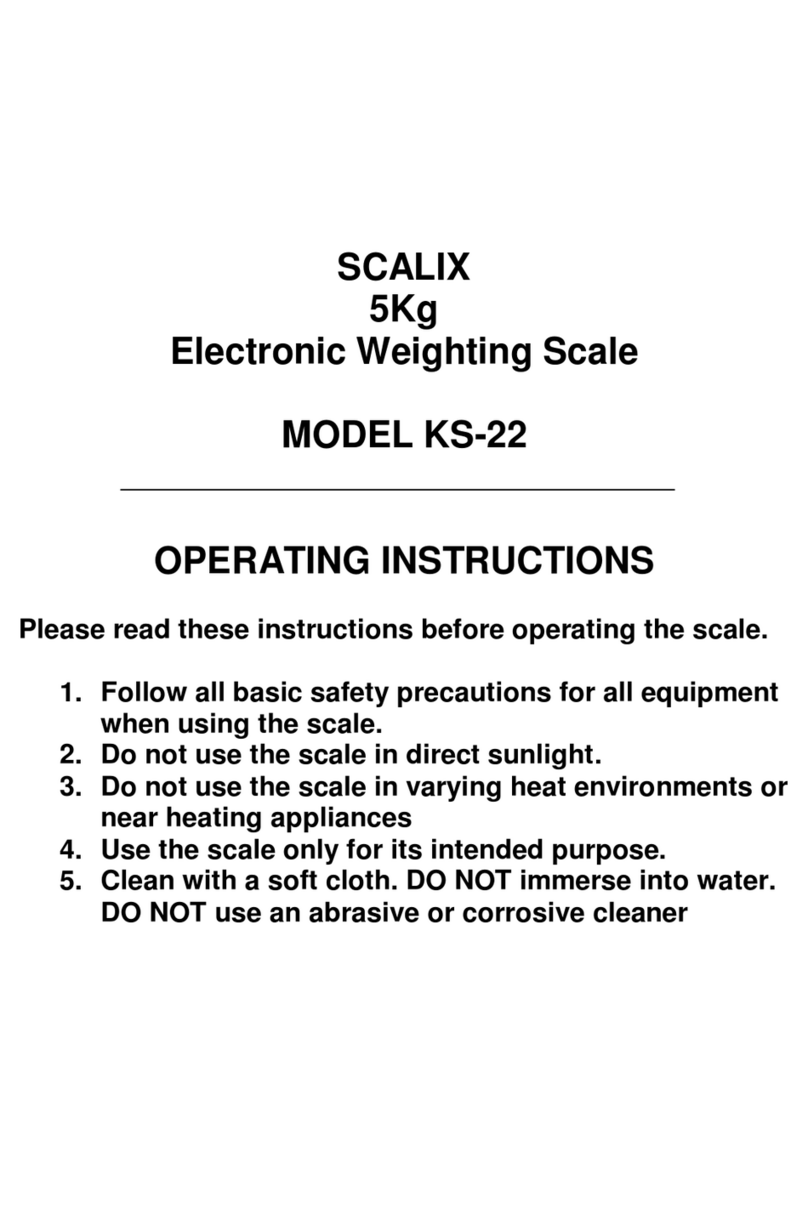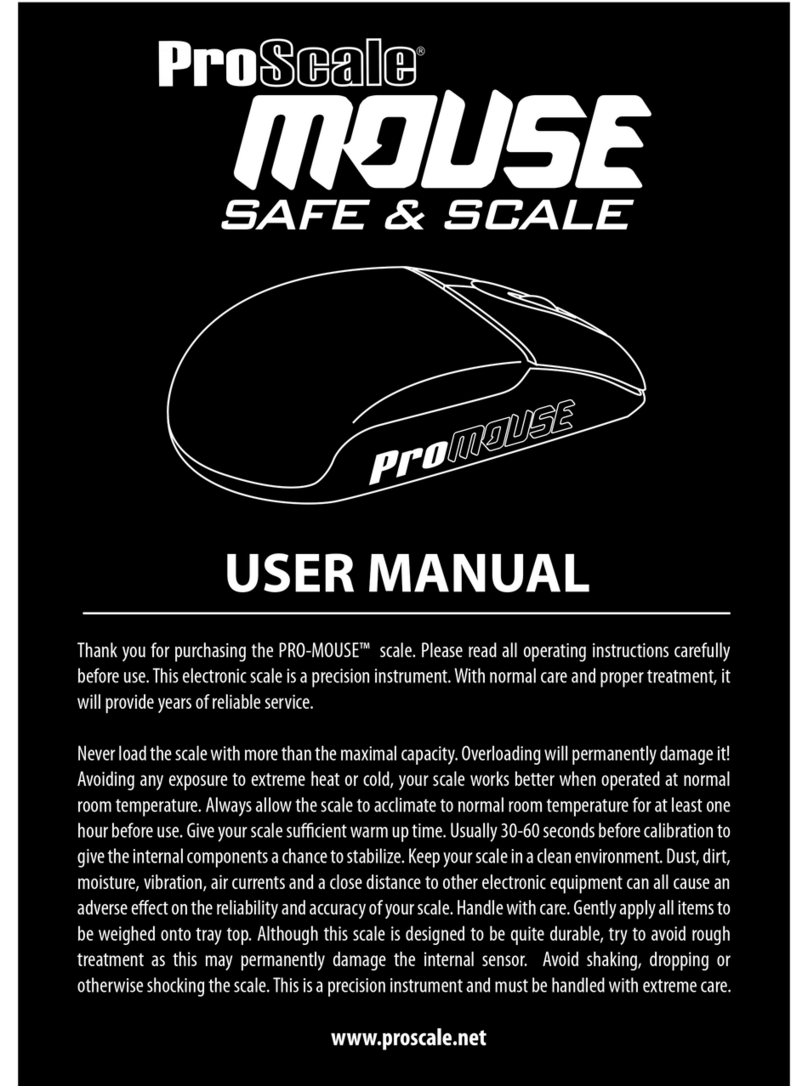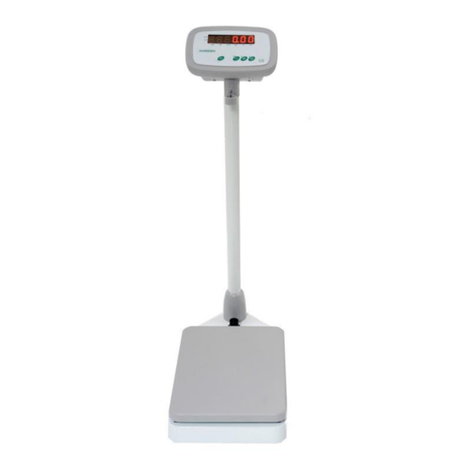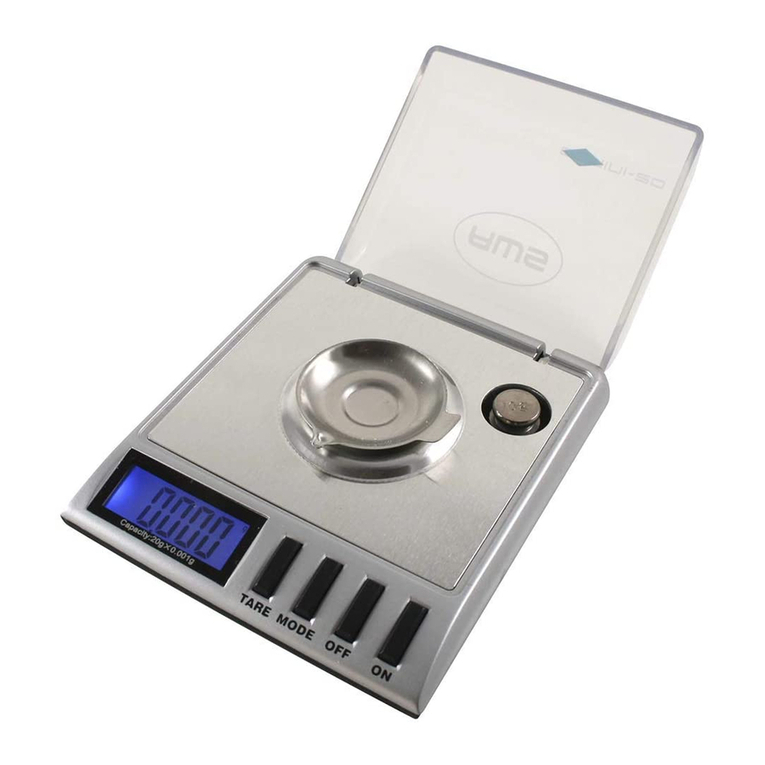Denver Instrument TB Series User manual

TB Series
TB-Serie
Electronic Analytical and Precision Balances
Elektronische Analysen- und Präzisionswaagen
Operating Instructions / Betriebsanleitung

2
English – page 3
Deutsch – Seite 51

3
Contents
Page
General View of the Equipment . . . . . . . . . . . . . . . . . . . . . . . . . . . . . . . . . . . . . . 4
Getting Started . . . . . . . . . . . . . . . . . . . . . . . . . . . . . . . . . . . . . . . . . . . . . . . . . . . . 5
Installation Instructions . . . . . . . . . . . . . . . . . . . . . . . . . . . . . . . . . . . . . . . . . . . . . 6
Connecting the Balance to AC Power . . . . . . . . . . . . . . . . . . . . . . . . . . . . . . . . . 10
Operating the Balance . . . . . . . . . . . . . . . . . . . . . . . . . . . . . . . . . . . . . . . . . . . . . . 12
Calibration/Adjustment . . . . . . . . . . . . . . . . . . . . . . . . . . . . . . . . . . . . . . . . . . . . . 14
Data Interface Port . . . . . . . . . . . . . . . . . . . . . . . . . . . . . . . . . . . . . . . . . . . . . . . . . 18
Below-Balance Weighing . . . . . . . . . . . . . . . . . . . . . . . . . . . . . . . . . . . . . . . . . . . 19
Troubleshooting . . . . . . . . . . . . . . . . . . . . . . . . . . . . . . . . . . . . . . . . . . . . . . . . . . . 20
Care and Maintenance . . . . . . . . . . . . . . . . . . . . . . . . . . . . . . . . . . . . . . . . . . . . . . 21
Configuring the Balance . . . . . . . . . . . . . . . . . . . . . . . . . . . . . . . . . . . . . . . . . . . . 22
Balance Operating Menu (Overview) . . . . . . . . . . . . . . . . . . . . . . . . . . . . . . . . . . 25
Application Programs . . . . . . . . . . . . . . . . . . . . . . . . . . . . . . . . . . . . . . . . . . . . . . 30
GLP/GMP-compliant Data Record . . . . . . . . . . . . . . . . . . . . . . . . . . . . . . . . . . . . 42
Specifications . . . . . . . . . . . . . . . . . . . . . . . . . . . . . . . . . . . . . . . . . . . . . . . . . . . . . 46
Declarations of Conformity . . . . . . . . . . . . . . . . . . . . . . . . . . . . . . . . . . . . . . . . . . 49

4
General View of the Equipment
No. Designation
10 CAL/CF key
(calibration/clear function)1)
11 Weight display
12 AC jack
13 Verification ID label with metrological
data for verified balances approved
for use as legal measuring instru-
ments
14 Manufacturer’s ID label with the
Cmark of conformity
15 Data interface port
16 Level indicator
17 Lug for fastening an antitheft locking
device
No. Designation
1 Weighing pan
2 Shield disk
3 Metrological ID label for verified bal-
ances approved for use as legal
measuring instruments
4 Menu access switch
5 Leveling foot
6 Function key (FUNCTION)
7 PRINT key (data transfer)
8 Tare key (TARE)
9 ON/OFF key
1) To activate the CF function, press and
hold for more than two seconds
16
15
14
13
12
1
2
3
4
5
11
3
10
9
6
7
8
15
4
12
16
17
1
5
14

5
Getting Started
The DENVER INSTRUMENT GMBH
product you have purchased meets
high quality standards and is
designed to assure many years of
trouble-free service.
Please read these operating
instructions carefully before you
begin to operate your new balance.
Warranty
In the unlikely event that your
balance should require servicing
within the 3-year warranty period,
please contact the office listed below
for your country, and state the model
number, serial number and the
problem:
Federal Republic of Germany:
DENVER INSTRUMENT GMBH
Robert-Bosch-Breite 10
37079 Goettingen, Germany
Phone (+49/551) 209773-0
Telefax (+49/551) 209773-9
Internet:
http://www.denverinstrument.com
E-mail: [email protected]
Storage and Shipping Conditions
Allowable storage temperature:
+5°C …+40°C
+41°F…+104°F
Unpacking the Balance
●After unpacking the balance,
check it immediately for any
visible
damage as a result of rough handling
during shipment.
$If you see any sign of damage,
proceed as directed in the chapter
entitled “Care and Maintenance,”
under the section on “Safety
Inspection.”
Save the box and all parts of the
packaging until you have successfully
installed your balance. Only the
original packaging provides the best
protection for shipment. Before
packing your balance, unplug all
connected cables to prevent damage.

6
Installation Instructions
For information on the current legal
requirements of your country, please
contact your local Denver customer
service office.
Information on Radio Frequency
Interference
Warning!
This equipment generates, uses and
can radiate radio frequency energy
and, if not installed and used in
accordance with the instruction man-
ual, may cause interference to radio
communications. It has been tested
and found to comply with the limits
for a Class A computing device pur-
suant to Subpart J of Part 15 of FCC
rules, which are designed to provide
reasonable protection against such
interference, when operated in a
commercial environment. Operation
of this equipment in a residential
area is likely to cause interference,
in which case the user, at his own
expense, will be required to take
whatever measures may be required
to correct the interference.
Ambient Conditions
The Denver Balance is designed to
provide reliable weighing results
under normal ambient conditions in
the laboratory and in industry.
When choosing a location to set
up your balance, please observe the
following so that you will be able to
work with added speed and accuracy:
– Set up the balance on a stable,
even surface
– Protect the balance from aggressive
chemical vapors
– Protect the balance from drafts
that come from open windows and
doors
– Avoid exposing the balance to
extreme vibrations
– Avoid exposing the balance to
extreme heat or to direct sunlight
Conditioning the Balance
Do not expose the balance to
extreme moisture over long periods.
Moisture in the air can condense on
the surfaces of a cold balance when-
ever it is brought to a substantially
warmer place. If you transfer the bal-
ance to a warmer area, make sure to
condition it for about 2 hours at the
new ambient temperature, leaving
it unplugged from the power supply.
Afterwards, if you keep the balance
connected to the power supply,
the continuous positive difference
between the inside of the balance and
the outside will practically rule out
the effects of moisture condensation.

7
Using Verified Balances as Legal
Measuring Instruments in the EU*
You must calibrate the balance at the
place of installation before using it as
a legal measuring instrument (see
“
Calibration/Adjustment,
”
page 14).
This balance is not allowed to be
used for weighing goods intended
for direct sale to the public. The type-
approval certificate for verification
applies only to non-automatic
weighing instruments; for automatic
operation with or without auxiliary
measuring devices, you must comply
with the regulations of your country
applicable to the place of installation
of your balance. A suitable thermo-
meter and barometer are recom-
mended for monitoring the ambient
conditions.
For balances of accuracy class k,
a thermometer and barometer are
recommended for monitoring the
ambient conditions. The temperature
range indicated on the verification ID
label must not be exceeded during
operation.
* including the Signatories
of the Agreement on the European
Economic Area
The balance must warm up for at
least 24 hours after initial connection
to AC power or after a relatively long
power outage.
The manufacturer complies with
EC Directive No. 90/384/EEC
non-automatic weighing instruments,
which has been in effect since
January 1, 1993, within the Single
European Market as well as the
accreditation of the quality manage-
ment system of the manufacturer
by Lower Saxony’s Regional
Administrative Department of Legal
Metrology (Niedersächsisches
Landesverwaltungsamt-Eichwesen)
from February 15, 1993.

8
Important Note Concerning All
Verified Balances Approved for Use
as Legal Measuring Instruments:
Provided that an official lead seal is
required for the verified balance, a
control seal is affixed to the balance.
Unauthorized attempts to remove
this seal will irreversibly damage it. If
you break the seal, the validity of the
verification will become void, and you
must have your balance re-verified.
Connecting the TB-215D Balance
to the Electronic Box:
– Plug the cable into the socket of
the electronics box.
Preparing Balances with a
Draft Shield Chamber
Place the following components
inside the chamber in the order
given:
– Shield disk
– Weighing pan

9
Preparing the TB-413A with a
Round Glass Draft Shield
– Place the shield disk on the balance.
Turn the disk counterclockwise until
it is securely fastened.
Place components listed below on
the balance in the order given:
– Pan support
– Weighing pan
– Glass draft shield cylinder
– Draft shield cover
Installing the Pan Draft Shield
on Model TB-4102A:
– Fasten the pan draft shield under
the metal part for grounding
Preparing Balances with a
Rectangular Weighing Pan
– Place the weighing pan on
the balance

10
Connecting the Balance to AC Power
The balance is powered by an AC
adapter. Make sure that the voltage
rating printed on this unit is identical
to your local line voltage.
Plug the cord of the AC adapter
into the DC jack; then plug the AC
adapter into a wall outlet (mains).
Leveling the Balance Using the
Level Indicator
At the place of installation, level the
balance using the leveling feet so
that the air bubble is centered within
the circle of the level indicator.
Retract the two auxiliary feet located
at the back of the balance.
Use the level indicator as a guide
to level the balance:
To lift the balance, extend the
leveling feet (turn clockwise).
To lower the balance, retract the
leveling feet (turn counterclockwise).

11
After retracting the rear auxiliary
feet, extend them until they touch the
surface on which the balance rests.

12
Operating the Balance
Warmup Time
To deliver exact results, the balance
must warm up for at least 30 minutes
after initial connection to AC power
or after a relatively long power out-
age. Only after this time will the bal-
ance have reached the required oper-
ating temperature.
Turning the Display On or Off
(Standby Mode)
Press the ON/OFF key to turn the
display on or off.
Self-Test
After the balance has been turned on,
an automatic self-test of the balance’s
electronic circuitry is performed.
At the end of the self-test, a zero
readout is displayed.
This means that the balance is ready
to operate.
Important Note Concerning Verified
Balances Approved for Use as Legal
Measuring Instruments:
For verified balances that have
a verification scale interval “e” which
is greater than the scale interval “d,”
the last digit on the display is bor-
dered.
▼

13
The display shows the following
special codes for your information:
Odisplayed in the upper right corner
stands for OFF
0displayed in the lower left corner
means standby
bmeans busy
Taring
A weight can be determined accu-
rately only from a defined zero point.
Press TARE to zero the weight
display.
You can tare within the entire weigh-
ing range of the balance.
Important Note Concerning Verified
Balances Approved for Use as Legal
Measuring Instruments in the EU*:
The small circle in the weight display
(on the left) shows that the balance is
exactly tared to “0” (±0.25 of a scale
interval).
Simple Weighing
Place your sample on the weighing
pan to determine the weight.
Read off the weight indicated on the
display only after the weight unit “g”
or a different unit selected appears
as the stability symbol.
* including the Signatories
of the Agreement on the European
Economic Area
b
0
o
0
▲
▲

14
Calibration/Adjustment
The balance offers you various
calibration/adjustment functions.
You can select these functions by
setting the appropriate menu code.
All models have a built-in calibration
weight.
Using Verified Balances as Legal
Measuring Instruments in the EU*
Before using your balance as a legal
measuring instrument, you must
perform “Internal Calibration” at the
place of installation after the warmup
period.
Menu code selection: 1 9 3 **
The calibration weight is internally
applied by servomotor and removed
at the end of calibration.
Calibration is the determination
of the difference between the weight
readout and the true weight (mass) of
a sample. Calibration does not entail
making any changes within the
balance.
Adjustment is the correction of this
difference between the measured
value displayed and the true weight
(mass) of the sample, or the reduc-
tion of the difference to an allowable
level within maximum permissible
error limits.
During calibration, the sensitivity
of the balance is adjusted to changes
in the ambient conditions.
Calibrate your new balance at
the place of installation after each
warmup period and before the first
weight measurement. In verified
models the balance should be
calibrated at least once a day.
▼
▼
When the display shows a zero
readout, press the CAL key to activate
calibration.
If any interference affects calibration,
the error message “Err 02” is
displayed briefly.
In this case, tare and press the CAL
key again.
Important Note
During calibration, the weighing pan
must be unloaded.
** including the Signatories
of the Agreement on the European
Economic Area
** = factory setting

15
External Calibration
Menu code selection: 1 9 1
Use only calibration weights with an
accuracy equal to or better than the
readability of your balance.
When a zero readout is displayed,
press the CAL key. This starts
calibration. The calibration weight
value in grams is then displayed.
Errors or interference at the start of
the calibration routine are indicated
by the error message “Err 02.”
In this case, tare and press the CAL
key again when a zero readout
appears.
Center the calibration weight on the
weighing pan.
The balance then calibrates automati-
cally. When calibration is completed,
the value of the calibration weight
and the stability symbol “g” are
displayed.

16
Calibration with a Built-in Weight
Menu code selection: 1 9 4
Substantial changes in barometric
pressure and temperature may affect
the display response of the balance.
To ensure that you obtain the full
accuracy of the balance, even when
you use the entire weighing range,
we have implemented a calibration
test function. It will help you to decide
quickly whether or not you need to
recalibrate your balance (for exam-
ple, to maintain the same accuracy
during long-term weighing series).
Unload the balance and tare.
When a zero readout is displayed,
press the CAL key. The built-in
calibration weight is now internally
applied by servomotor. At the same
time, CAL is displayed. After the
display has stabilized, the deviation
of the momentary readout from the
target weight (in grams only) is
indicated.
If external interference affects the
calibration test, the error message
“Err 02” is displayed briefly. In this
case, tare and then press the CAL key
again.
Important Note
The balance should be calibrated
if the deviation of the readout from
zero is more than the reproducibility
specified for your balance; see the
“Specifications” starting on page 46.

17
To calibrate the balance with the
built-in weight:
press the CAL key briefly
or
to quit the calibration test:
hold down the CAL key for more than
2 seconds
Blocking the Calibration Functions
You can block the calibration func-
tions by setting code 1 9 7 (when the
menu access switch is locked).

18
If you wish to record weighing data
using a Denver printer, plug the
printer connector into the interface
port of the balance.
Important Note Concerning Verified
Balances Approved for Use as Legal
Measuring Instruments:
When using the balance as a legal
measuring instrument, you may
connect it only to auxiliary measuring
devices that are legally permitted.
However, if you are not using the bal-
ance as a legal measuring instrument,
you may connect it to any peripheral
devices that you wish, e.g., additional
remote displays, personal computer,
etc. Such peripheral devices must be
marked to indicate that they may not
be connected when the balance is
being used as a legal measuring
instrument.
Important Note
Make sure to unplug the balance
from AC power before you connect
or disconnect a peripheral device
(printer or PC) to or from the interface
port.
To print data on hard copy or output
it to a computer screen, press the
PRINT key.
For information about the data output
parameters and data ID codes, see
page 28. For details on the data
interface (such as the data output or
input formats, pin assignment, etc.),
contact Denver.
Data Interface Port

19
A port for a below-balance weighing
hanger is located on the bottom of
the balance:
To open the below-balance port, turn
the cover plate.
Important Note
When you use a below-balance
weighing hanger, you must install
a shield to protect against drafts.
For Precision Balances
(Except for TB-6201A):
To open the below-balance port,
remove the cover plate from the bot-
tom of the balance.
Now you can attach a sample using
a suspension wire, for example.
Common applications for below-
balance weighing include density
determination and immersing a
sample in a special atmosphere
(medium for reaction).
Fastening an Antitheft Locking
Device1)
To fasten an antitheft locking device,
use the lug on the rear panel of the
balance.
* including the Signatories of the
Agreement on the European
Economic Area
1) = Not applicable for
TB-215D/-224A/-124A
Below-Balance Weighing
Important Note Concerning Verified
Balances Approved for Use as Legal
Measuring Instruments in the EU*:
The below-balance weighing port
may not be opened or used when an
approved balance is being operated
as a legal measuring instrument.

20
Troubleshooting
Problem Causes Solution
No segments appear on the No AC power is available Check the AC power supply
weight display The AC adapter is not Plug in the AC adapter
plugged in
No segments appear on The surface on which the Make sure that the ambient
the weight display after balance rests is not stable conditions are stable
calibration/adjustment
Internal stability has not Prevent vibrations from
been reached affecting the surface on
which the balance rests
Close the draft shield
The weight display The load exceeds the Unload the balance
shows “H” capacity of the balance
The weight display The weighing pan Position the pan and/or the
shows “L” and/or the pan support pan support disk (depending
or “Err 54” disk is not in place on the balance model)
The weight display briefly The display did not show Press the TARE key; then
shows a zero readout when the press the CAL key again
“Err 02” CAL key was pressed
to calibrate
The balance is loaded Unload the balance
The special code “b” does None of the keys has been Press a key
not go out on the weight pressed since the
display balance was turned on
The weight readout Unstable ambient conditions Set up the balance in
changes constantly another area
Too much vibration or the Access the menu to select
balance is exposed to a draft the correct code for the
weighing environment
The weight readout is The balance is not calibrated Calibrate the balance
obviously wrong
The balance was not tared Tare before weighing
before weighing
The air bubble of the level Level the balance
indicator is not centered
within the circle
This manual suits for next models
6
Table of contents
Languages:
Other Denver Instrument Scale manuals

Denver Instrument
Denver Instrument DA Series User manual

Denver Instrument
Denver Instrument MAXX User manual
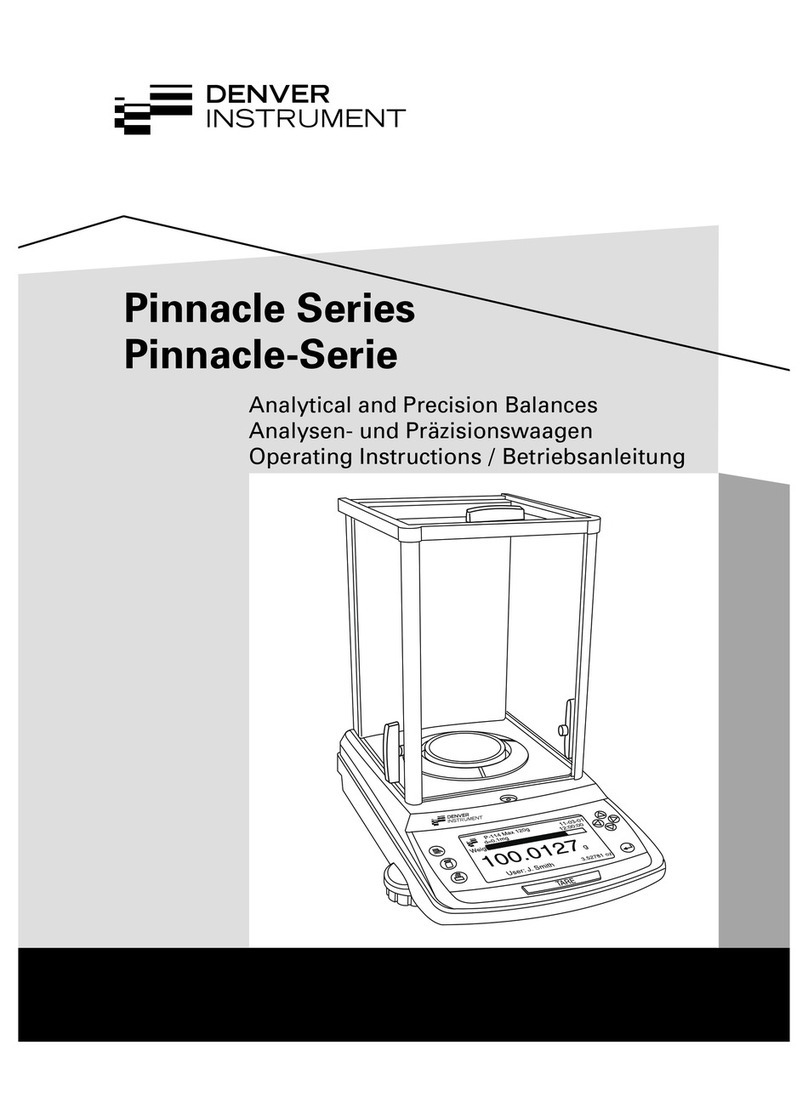
Denver Instrument
Denver Instrument P-114 User manual
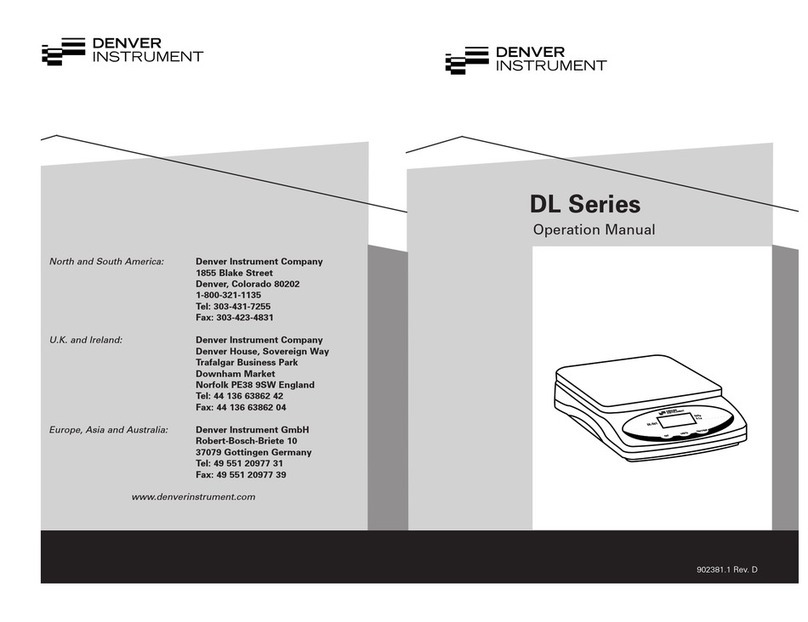
Denver Instrument
Denver Instrument DL series User manual
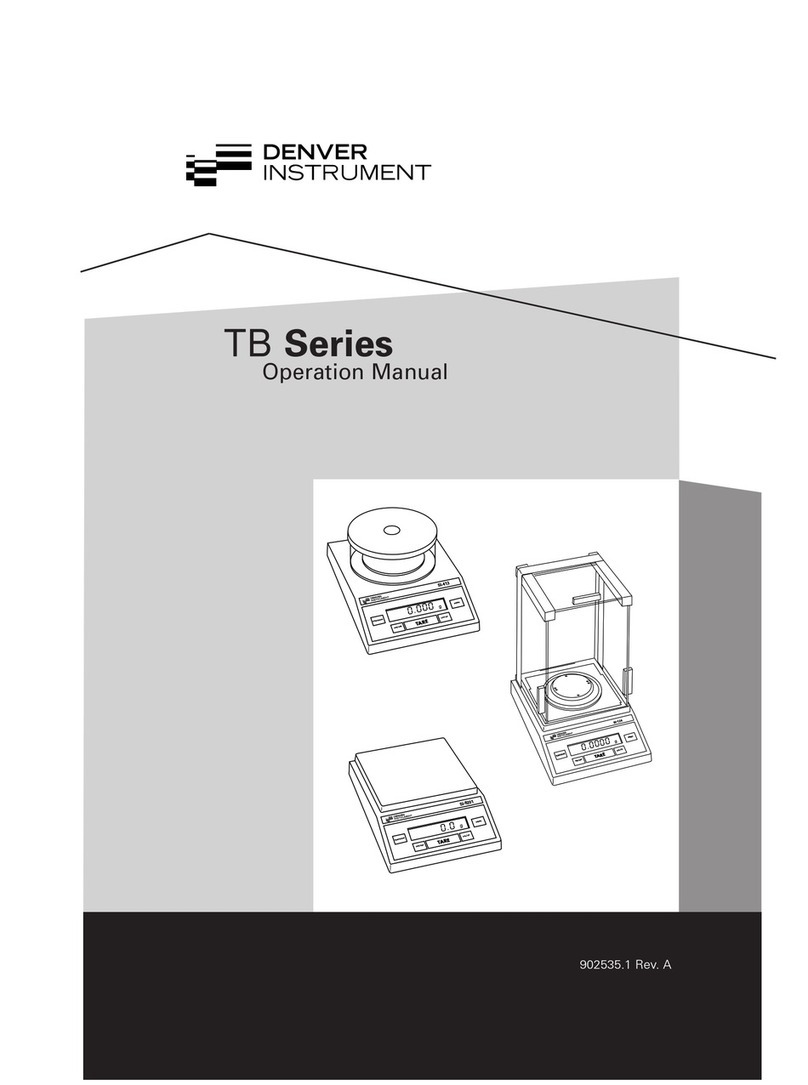
Denver Instrument
Denver Instrument TB-124 User manual
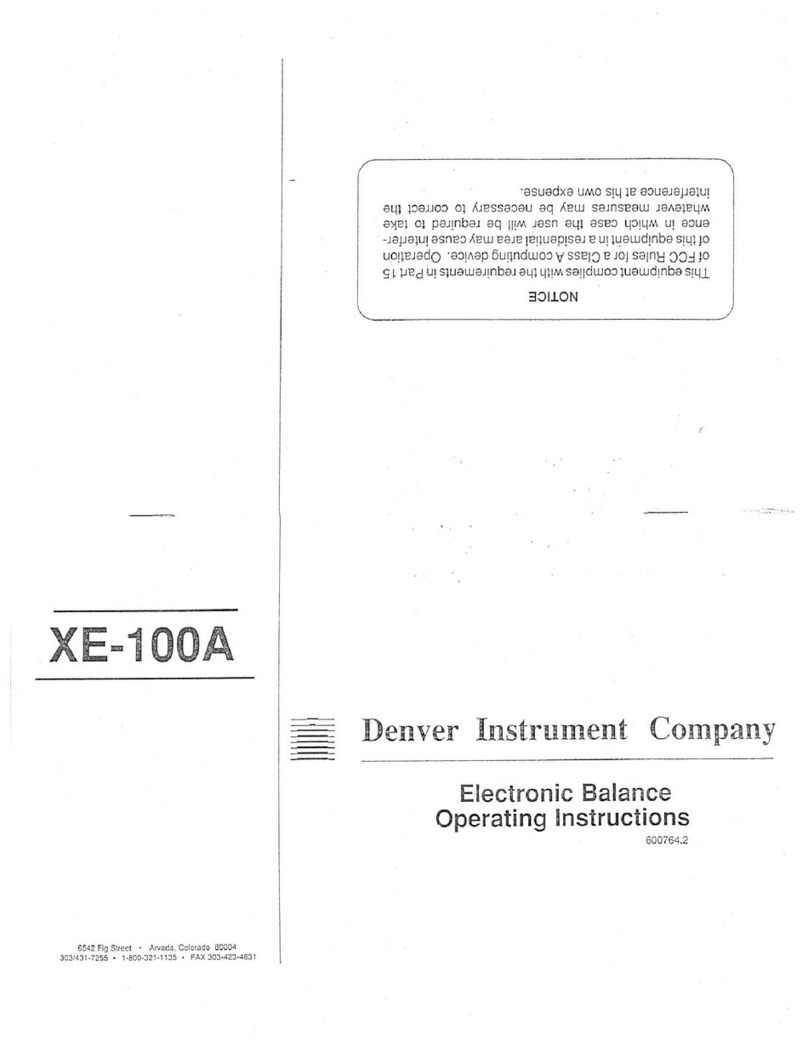
Denver Instrument
Denver Instrument XE-100A User manual

Denver Instrument
Denver Instrument Tl-series User manual

Denver Instrument
Denver Instrument TP Series User manual
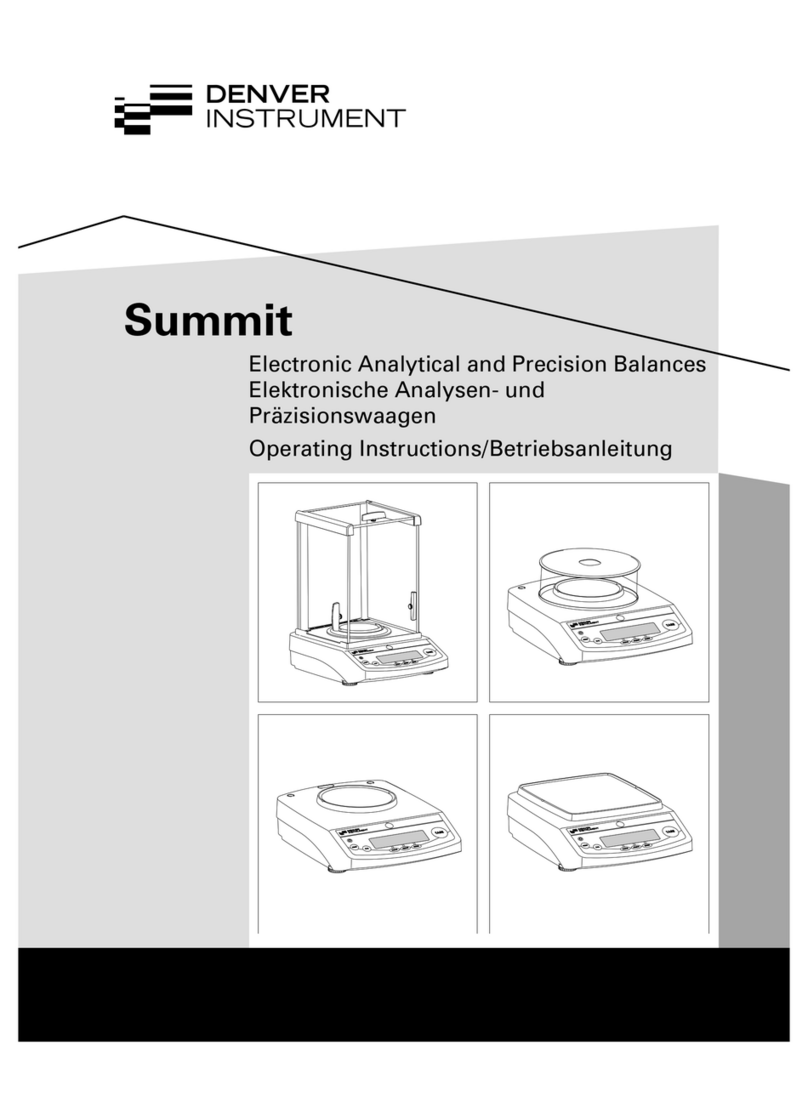
Denver Instrument
Denver Instrument Summit User manual
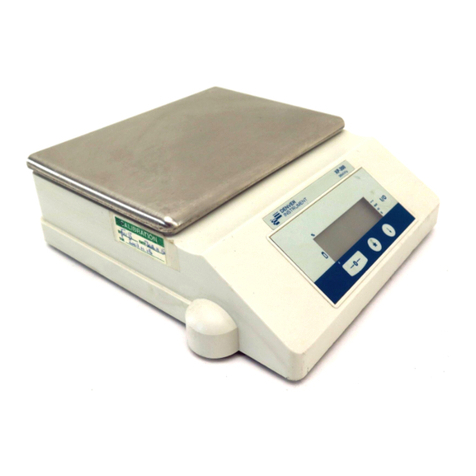
Denver Instrument
Denver Instrument XP Series User manual


